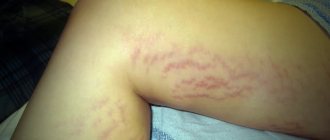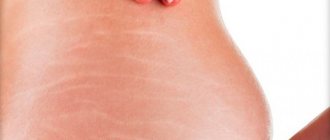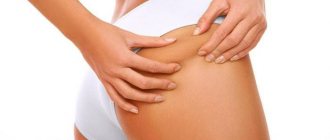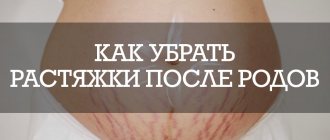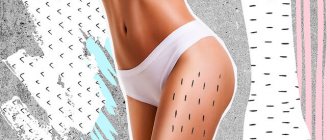Striae (stretch marks on the skin, striae distensae, stretch marks) are linear scars on the skin that usually develop on the body in places of linear stretching and can appear in people of any race and gender between the ages of 5 and 50 years. In women, stretch marks occur approximately twice as often as in men. Since stretch marks are essentially scar changes in the dermis caused by rupture of the connective tissue matrix, they persist for life. After pregnancy, stretch marks occur in 80–90% of cases, therefore, the International Classification of Diseases separately distinguishes stretch marks of pregnancy (EE30.10).
Since one of the main causes of stretch marks is overstretching of the skin due to rapid growth or increase in body volume, they often develop in adolescence, in bodybuilders gaining muscle mass, as well as in obese people. Striae can occur as a result of various diseases - for example, Cushing's and Marfan's syndromes. They also appear with long-term use of steroid hormones or their local application to the skin under occlusive (tight) dressings.
Striae are always localized on the body, and in pregnant women they usually appear in the abdomen and mammary glands; in athletes, they usually appear in the armpits, shoulders and thighs. In adolescents and obese individuals, stretch marks appear on the back, abdomen, legs and other areas, depending on which area of the body has sharply increased in size.
Unfortunately, despite many advances in the treatment of striae in recent years, there is no completely effective treatment for this skin condition. This situation is due to the fact that striae are already formed scar tissue of connective tissue fibers. Completely removing it and returning the original tissue again is a task that is currently beyond the control of a cosmetologist. In addition, it is necessary to approach the issue comprehensively, using several techniques sequentially or a combination of them. Unfortunately, the same technique cannot be universal in the treatment of any stretch marks.
Immediately after the appearance of striae, they are flat pinkish or reddish skin defects of short length - they are called striae rubra (red stretch marks, Fig. 1).
RICE. 1. RED STRIAE RUBRA.
Gradually, the defects mature and turn into white wrinkled scars - striae alba (white stretch marks, Fig. 2).
RICE. 2. WHITE STRIAE ALBA.
Typical striae alba have a length of up to several tens of centimeters and a width of 1 to 10 millimeters. They are a scar with a high density of connective tissue fibers and poor extensibility.
Based on the clinical picture, striae are classified according to stages of development and severity:
| STAGE | CLINICAL MANIFESTATION |
| Stage I | Fresh, inflamed, usually purple streaks |
| Stage II | White superficial grooves without gradation and without noticeable depression on the surface of the skin |
| II-b stage | White superficial grooves without gradation, but with a noticeable depression on the surface of the skin |
| III-a stage | White atrophic grooves with steps, less than 1 cm wide, without deep dyschromia |
| III-b stage | White atrophic grooves with steps, less than 1 cm wide, with deep dyschromia |
| IV stage | White atrophic grooves with gradations, more than 1 cm wide, with or without deep dyschromia |
Since stretch marks are mainly an aesthetic problem and do not cause patients other inconveniences characteristic of post-traumatic scars, such as discomfort and limited mobility, treatment comes down to a set of measures to reduce their visible manifestations. Hardware methods of influencing the skin, which have been actively developed over the past few years, in some cases show high effectiveness in the treatment of stretch marks. These include the use of the following types of lasers: CO2, Er: YAG, Er: fiber (Er: glass), diode, Nd: YAG pulsed dye, and excimer. There is evidence of the effectiveness of treating striae with devices that use intense pulsed light (IPL).
Among non-light techniques, radiofrequency exposure shows promising results - RF devices, both non-invasive and minimally invasive - needle-type. Based on the differences in the principle of operation of all of these devices, one can expect different effects and effectiveness in the treatment of stretch marks of different stages. Let's consider the methods that will be most effective in treating a certain type of stretch marks.
Red stretch marks (stage I)
These striae are in the formative stage, the inflammatory reaction in response to damage and active neoangiogenesis is the cause of visible manifestations - red and purple stripes. When treating such striae, it makes sense to direct the effect to reduce the vascular component, so selective destruction of blood vessels by heating hemoglobin will be effective. IPL and vascular lasers, such as dye and copper vapor lasers, are good options for treating stretch marks. At the same time, IPL therapy will be more convenient for the doctor and the patient, especially in cases where it is necessary to treat large areas covered with striae.
When treating red stretch marks with IPL, you can achieve their significant lightening after the first procedure, but you need to remember that this will be ineffective if the formation of stretch marks continues - new breaks appear and old ones increase. Therefore, when treating stretch marks red, it makes sense to make sure that the process of their formation is complete, and only then begin treatment: for example, when treating stretch marks after pregnancy, you should wait until your body weight stabilizes after childbirth and only then start IPL or laser therapy.
White stretch marks (stages II – IV)
Visually, white striae at any stage look like areas of tissue that are paler in relation to the surrounding skin. Therefore, one of the main tasks of their correction is to even out the color by smoothing the boundaries with the surrounding tissue. Skin surface remodeling techniques, primarily fractional photothermolysis, cope well with this task. Fractional ablative lasers destroy micro-areas of tissue along the entire length of the striae, as well as in healthy skin around it, by abruptly evaporating moisture in the cells, which leads to their instant overheating. During the healing process, a restructuring of the scar tissue of the striae itself and the surrounding dermis occurs, as well as renewal of the surrounding epidermis, migration of melanocytes to the stretch area and activation of melanin synthesis. Thanks to these processes, the surface of the striae begins to resemble the surrounding tissue more and more, and at the same time its width decreases. When treating atrophic striae, fractional photothermolysis procedures can also improve their relief: smooth out the gradation and raise the bottom of the striae to the level of the surrounding tissue. Fractional photothermolysis for the treatment of stretch marks always requires multiple procedures, and good results can be obtained when treating stretch marks of small width.
Wide stretch marks (III – IV stage)
It is important to understand that the surface of stretch marks, like the surface of any other scar, is devoid of skin patterns. Therefore, no measures using laser techniques can completely eliminate stretch marks, and they will be ineffective when it comes to treating widespread stretch marks. Even if a striae 10 mm wide (stage IV) is similar in color to the surrounding tissue and tans in a similar way, it will still stand out on the surface of the skin with shine and the absence of a skin pattern. The only effective way to treat wide stretch marks is surgery - plastic surgery with removal of a flap of skin and relocation of a healthy area. This method can be combined with laser procedures, since fractional lasers can improve scars left after plastic surgery.
Causes of deep stretch marks
Our skin contains fibers consisting of elastin and collagen. If it so happens that a woman suddenly begins to gain weight or, conversely, goes on a strict diet and begins to rapidly lose weight, then the upper layer of skin can still somehow adapt to such changes, but the deeper layer is not so elastic and does not have time to rebuild. Collagen fibers rupture and bright pink or red scars form at the site. Such a bright color is due to the fact that hemorrhage occurs at the site of the rupture. Over time, the color of the furrow lightens and becomes less noticeable.
The main stimulating factors for the occurrence of stretch marks:
- Pregnancy is the most favorable period for the appearance of stretch marks. At first, a woman rapidly gains weight against the background of a hormonal surge, and then just as abruptly loses it. Deep stretch marks appear on the abdomen, thighs, chest and buttocks.
- Treatment with hormones. Hormonal therapy causes fluid retention in the body, body volume increases, the skin stretches, collagen fibers cannot withstand and, as a result, deep stretch marks throughout the body.
- Hormonal changes during puberty and intensive growth.
Ablative and non-ablative fractional lasers for the treatment of stretch marks
For many years, there has been a debate between manufacturers of fractional lasers about the effectiveness of their use for the treatment of stretch marks. Ablative and non-ablative fractional lasers trigger similar biological processes in tissues, which result in remodeling of the skin surface and smoothing of stretch marks. Since striae is a dermal formation, its correction requires thermolysis at the level of the dermis - lasers that reach the depth of the reticular layer of the dermis will be effective. The first, and most important, difference between lasers is the damage or, conversely, preservation of the epidermis. Ablative lasers “evaporate” all cells in their path without exception, and the activity of non-ablative lasers is configured so that only the dermal level is damaged without damaging the surface tissues - the epidermis. Ablative lasers are much more aggressive than non-ablative lasers and have a greater stimulating effect than the latter. Therefore, with all other parameters being equal (depth of exposure, percentage of coverage), an ablative fractional laser will be more effective than a non-ablative one, especially for CO2 lasers. However, the use of ablative lasers in areas where stretch marks are localized is fraught with discomfort and the development of complications. During rehabilitation, which takes from 3 to 5 days, it is necessary to protect the treated surface with a sterile bandage and avoid friction with clothing. The use of ablative fractional lasers on the body - in the abdomen, chest, hips - often ends in the development of post-inflammatory hyperpigmentation - an unpleasant, although temporary, phenomenon. Another disadvantage of fractional ablative lasers, in addition to complex rehabilitation, is rupture of striae due to incorrect procedure technique, which results in the formation of scars. This complication may be due to the fact that ablation microzones formed in the atrophy zone at the site of the striae make it weak to rupture, and subsequent stretching can provoke such a rupture.
RICE. 3. A - BEFORE TREATMENT, B - 2 MONTH AFTER 1 PROCEDURE OF NON-ABLATIVE FRACTIONAL PHOTOTHERMOLYSIS M22‑RESURFX. Photos in Fig. 3 and 4 kindly provided by Dr. E. L. Baranova.
RICE. 4. A - BEFORE TREATMENT, B - 1 MONTH AFTER 1 PROCEDURE OF NON-ABLATIVE FRACTIONAL PHOTOTHERMOLYSIS M22‑RESURFX.
RICE. 5. STREAMS IN THE BREAST AREA. A - BEFORE TREATMENT, B - AFTER 3 PROCEDURES OF NON-ABLATIVE FRACTIONAL PHOTOTHERMOLYSIS M22‑RESURFX. Photo courtesy of Dr. Matteo Tretti Clementoni.
Thus, we can say that non-ablative fractional lasers, despite their lower efficiency compared to ablative ones, are more preferable in the treatment of stretch marks. Classic non-ablative fractional lasers for the treatment of striae are Fraxel 1550 nm and ResurXF 1565 nm (Fig. 3-5). Both of these lasers are capable of creating zones of fractional photothermolysis 1 mm or more deep and are excellent for use on the body as they do not disrupt the skin barrier functions.
How to remove deep stretch marks: options for fighting
Modern doctors are constantly looking for a way that would once and for all rid women of such a problem as deep stretch marks. But a single miraculous method suitable for everyone has not been invented. The fight against deep stretch marks must be approached individually and take into account the characteristics of the body and the reasons for their occurrence.
Modern medicine offers several ways to remove deep stretch marks:
- Cosmetic methods (creams, oils, massages, seaweed wraps, mesotherapy, ozone therapy) can only remove minor external manifestations of stretch marks. Deep stretches are more difficult to deal with using these methods and you need to act comprehensively, using several methods at once.
- Chemical peeling is done using a special acid; it will do a great job of removing stretch marks. The acid penetrates deeply into the skin and burns its deep layers along with stretch marks. This is a very painful and painstaking procedure, equivalent to surgery and is performed under general anesthesia. Rehabilitation lasts several days.
- Laser resurfacing, as well as chemical peeling, is great for treating deep stretch marks. But again, as in the previous case, hospitalization followed by rehabilitation will be needed.
- Plastic surgery is the most radical method of dealing with deep stretch marks. The surgeon simply cuts out an unsightly area of skin.
Combined hardware technique for the treatment of striae IPL+ResurFX+Tripollar
We found that the choice of hardware technique in the treatment of striae is related to the stage of the process, and non-ablative procedures are safer and, as a result, preferable. Based on this, a promising technique is the sequential use of procedures - IPL therapy, non-ablative fractional photothermolysis and multipolar RF lifting. This complex consists of 2 – 3 IPL therapy procedures, which are aimed at treating stretch marks red and are carried out provided that the patient’s body weight is stabilized and the risk of new breaks is minimal. The procedures are performed on the IPL module of the M22 device (Lumenis, Israel), equipped with pulse optimization technology and a set of replaceable light filters that allow you to select the optimal selective effect on the vascular component of striae when treating patients with different phototypes.
Next, a complex of 4 to 7 procedures is applied using the non-ablative fractional laser ResurFX 1565 nm (also a module of the M22 device). These procedures are aimed at smoothing the skin texture and smoothing out stretch marks. They are carried out at intervals of 4 - 5 weeks, their number depends, first of all, on the width of the stretch marks: the narrower the stretch marks, the fewer procedures will be needed. If, in addition to correcting stretch marks, the task is to tighten the skin, which often happens when treating patients recovering from pregnancy or sudden weight loss, then in addition to the course of ResurFX procedures, multipolar RF lifting using TriPollar (Pollogen) technology should be used. The procedures are performed with an interval of 2 weeks, or simultaneously with the procedures on ResurFX. Provided that the patient undergoes the latter every 4 weeks, TriPollar procedures can be performed on him at each such visit, as well as in the intervals between them.
Treatment of skin stretch marks, along with the treatment of scars, is one of the most difficult tasks in therapeutic cosmetology. However, the choice of modern hardware techniques, focused on the clinical manifestations and stages of stretch marks, a combination of these techniques, as well as competent treatment planning can bring significant success.
Prevention of deep stretch marks
The rule “The best treatment is prevention” also applies to deep stretch marks. It is better to take care of the condition of your skin in advance:
- There is no need to experiment with “express diets”. Weight loss should be gradual.
- When carrying a child and after childbirth during lactation, be sure to wear a special support belt and bra.
- Increase skin tone and elasticity. In this case, all methods are good. Use special creams, take a contrast shower, massage and rub to increase blood circulation. Eat right and make sure you take additional vitamins A and E. Jojoba and neroli oils, which need to be rubbed into the skin, provide good prevention against deep stretch marks.
Camouflage tattoo ↑
The most innovative technique for combating stretch marks, which helps disguise imperfections and make them the same tone as normal skin.
The best results will be achieved with light-colored stretch marks - in this case it is easier to select the exact pigment. Tattooing of stretch marks can be done on any area of the body, even on such a sensitive area as the chest. In its technique, the procedure is closer to permanent makeup than to classic tattooing, and therefore is not so painful. Pros:
| guaranteed result after the first procedure; | |
| can be done on any area of the body; | |
| if the result does not suit the client, the pigment can be removed from the body; | |
| no other procedure can dramatically affect the white color of striae. |
Minuses:
| corrects only the color of stretch marks, but does not even out the skin texture; | |
| a very expensive and rarely used service due to its novelty; | |
| there is a rehabilitation period and side effects; | |
| does not affect the quality of the skin; | |
| the effect lasts for several years, then a repeat procedure is necessary; | |
| Striae become visible when tanning. |
What result to expect
By approaching the question “how to remove deep stretch marks” wisely, having patience and completing the task, you will soon be able to admire your smooth, healthy skin again.
But remember! Once you get rid of deep stretch marks, you are not immune to the fact that they will not appear again. Take care of your body and don't forget to take preventative measures.
Fractional thermolysis against stretch marks: before and after
Classification
Striae that appear on the body of men can be very different. There are several classifications, so depending on the color, stretch marks are distinguished:
- White. These are older defects, those that appeared earlier than six months ago.
- Reds. They are new, fresh, and often even very painful. It is much easier to remove such defects.
Depending on the direction, there are stretch marks:
- Vertical. Most often they appear not in men, but on the stomach and arms of women, in particular pregnant women. In males, longitudinal striae may appear due to obesity or frequent muscle overload.
- Horizontal. This type is usually a manifestation of diseases of the endocrine system.
The location of stretch marks can be very different: on the shoulders, on the forearm, on the stomach, in the groin, on the buttocks and thighs.
Striae - a cosmetic problem
In the United States, approximately 90% of pregnant women, 70% of teenage girls, and 40% of boys (especially athletes) have stretch marks, according to Medscape.com. These data can be extended to all other countries and races.
Typically, stretch marks are a cosmetic problem, but with a sudden injury or sudden overextension, first tearing, then inflammation and ulceration of the skin are possible.
Striae appear in the form of flat thinning skin of a pink hue, itching from time to time. Gradually, the stretch marks increase in length and width and become reddish-purple (striae rubra). The surface of the striae may become covered with fine wrinkles. Mature striae are white, receding, irregularly shaped stripes, parallel to the lines of skin tension along the long axis, on average several centimeters in length and 1-10 mm in width. Over time, some stretch marks may disappear or become less noticeable. The natural evolution of stretch marks is similar to the formation of scar tissue during wound healing.
During pregnancy, stretch marks usually affect the abdomen and mammary glands. The most common areas with stretch marks in adolescents are located on the outer surfaces of the thighs and lumbosacral region in boys and on the thighs, buttocks, and mammary glands in girls. Less commonly, other areas, such as the upper arms, are affected.
Striae induced by long-term use of systemic steroids are usually longer and wider than other types of stretch marks; damaged areas are also capable of expanding, involving more and more parts of the body, sometimes the face. Stretch marks may occur as a side effect of long-term use of topical corticosteroids under occlusive dressings. This kind of stretch marks occurs in places where bandages are applied and usually goes away on their own after discontinuation of local treatment.
Cosmetic procedures and products ↑
Chemical peels
Superficial peels are ineffective against stretch marks, so cosmetologists use medium and deep peels in such cases. The principle of operation here is almost the same as with laser resurfacing (controlled tissue trauma to stimulate skin renewal), with the only difference being that the effect is carried out using chemical compounds.
After the procedure, the skin becomes red and swollen; after a few days, the process of intensive exfoliation begins, which usually lasts about a week.
After healing, stretch marks become less noticeable. Remember that the treatment area should not be tanned for two months after the procedure (this can lead to severe pigmentation). Pros
:
| reduces stretch marks of any nature and age; | |
| the service is available in most beauty salons; | |
| does not require pain relief; | |
| global skin rejuvenation; | |
| cheaper than other professional procedures. |
Minuses:
| allergic reactions are possible; |
| The treatment area should not be rubbed. |
Scrubbing
The scrub is an affordable and easy-to-use product that can be used at home. It can not only cleanse the skin, but also stimulate cell renewal. With regular scrubbing (1-2 times a week), stretch marks gradually become less noticeable.
The effectiveness largely depends on the composition of the scrub. It is important that it contains sufficiently hard exfoliating particles (soft ones against stretch marks are simply ineffective): crushed nut shells or fruit seeds, salt, granulated sugar. Ideally, in addition to scrubbing components, the product contains ingredients for toning, lifting, and nourishing the skin.
| The ARAVIA Laboratories brand has products that meet these requirements - these are Raspberry Cream Scrub and |
Pros:
| can be used at home; | |
| It is enough to use 1-2 times a week; | |
| pregnancy is not a contraindication; | |
| affordable price and economical consumption; | |
| It affects not only stretch marks, but also acne marks, cellulite, pigmentation and other imperfections. |
Minuses:
| effectiveness greatly depends on the scrub chosen; | |
| the result appears after a long time; | |
| low effectiveness with old stretch marks. |
Self-massage with a dry brush
The second name of this method is “drybrushing”. This is another option for mechanical exfoliation. A huge plus is the lack of consumables and the ability to perform a massage anywhere and anytime - even in your own bedroom, while watching your favorite TV series.
With regular use of the brush, the skin is cleansed of keratinized particles, renews itself faster, becomes smooth, cellulite and stretch marks become less pronounced. The main rule of dry massage is that movements should be in the direction of the lymph: from the feet to the heart.
For a massage to be effective, it is important not only to do it correctly, but also to choose a quality brush. Dry massage brushes ARAVIA
made of beech wood and natural bristles. Natural materials will make the procedure tactilely pleasant, and the long handle will allow you to work on hard-to-reach areas.
>> How to do drybrushing correctly, we tell you in the article “Massage with a dry brush: technique, tips and contraindications”
Pros:
| does not require consumables; |
| can be used at home, and not necessarily in the bathroom; |
| effective against cellulite. |
Minuses:
| the result appears after a long time; | |
| low effectiveness with old stretch marks; | |
| It is important to follow the massage technique. |
Preventive measures to prevent the appearance of stretch marks on the body
Regular nutritional monitoring can help prevent stretch marks. It should be complete, healthy and balanced. The diet should include vitamins, amino acids, and microelements, which are found in sufficient quantities in fruits, vegetables, dairy products, fish, low-fat protein products, and whole grain bread. You need to drink plenty of water every day. Massage, water treatments, and swimming are also welcome.
Experts will help you make stretch marks as invisible as possible using modern methods and technologies. They will offer injections of animal collagen into problem areas, mesotherapy, laser treatment or surgical excision.
(No ratings yet)
Tags:causes of stretch marks on the body, prevention and treatment of stretch marks, Stretch marks on the body in men
Diagnostics
Diagnosis of stretch marks includes:
- analysis of patient complaints;
- examination of the skin;
- blood test to determine cortisol levels.
If there is a suspicion of endocrine system pathology, additional examinations are carried out:
- determination of the level of cortisol in daily urine;
- Ultrasound of the adrenal glands;
- determining the level of adrenocorticotropic hormone in the blood (this hormone regulates the activity of the adrenal glands);
- MRI or CT scan of the adrenal glands;
- MRI or CT scan of the pituitary gland.
The patient may also need to consult an endocrinologist.
